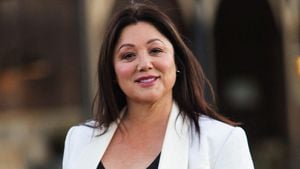Colleges and universities across the United States find themselves at a significant crossroads following the recent Supreme Court decision to ban affirmative action. This ruling has raised serious questions about how institutions will adapt their admissions policies, especially concerning diversity. At Duke University, officials still seem committed to enhancing socioeconomic diversity and racial equity within their student body, even amid the dramatic shifts following the court's decision.
The Class of 2028 at Duke, consisting of 1,733 students, reflects notable improvements, particularly with 22% being Pell Grant-eligible, which is double the percentage from its Class of 2026. This increase is particularly compelling when set against the backdrop of national stats, especially as many elite educational institutions have begun experiencing declines in racial diversity.
Despite the Supreme Court's ruling overturned affirmative action—signifying limitations on recruiting students of color—Duke has managed to maintain stability within its racial profile. Notably, 13% of the incoming students are Black—consistent with previous classes meanwhile representing 14% of Hispanic/Latinx students. These figures speak volumes, indicating the administration's focus on attracting diverse student groups.
What's intriguing is the comparative success of Duke against its peer institutions. For reference, institutions like Harvard College saw its percentage of Pell Grant-eligible students drop slightly to 20.4%, illustrating just how different outcomes can be among these elite schools. On the other hand, the Massachusetts Institute of Technology (MIT) reported 24% for the same category, showcasing its commitment to socioeconomically diverse representation.
Duke's commitment has also translated to financial aid statistics, increasing from 50% of aid recipients among the Class of 2026 to 56% for the Class of 2027. These efforts align with criticisms previously leveled against Duke for being “one of the least economically diverse colleges” ranked among elite universities.
One curious aspect of the new admissions policy is the move toward embracing factors beyond race for admissions. With the Supreme Court ruling, institutions are now prohibited from using racial data, altering strategy to focus on financial circumstances. Interestingly, Duke claims it has never employed a need-aware process, emphasizing equitable access.
This shift does, nonetheless, come after Duke faced legal issues stemming from allegations of employing need-aware admissions practices alongside 17 other prestigious schools. The lawsuit resulted in Duke settling for $24 million, which grants eligible students and alumni access to compensation dating back to 2003. The case raised serious questions about economic barriers faced by students seeking higher education.
There’s also been consternation around the adjustments made following the Supreme Court ruling. A notable change was the announced termination of the Reginaldo Howard Memorial Scholarship Program, crafted to support top applicants of African descent. This program has been replaced with the Reginaldo Howard Leadership Program, now opened to all undergraduate students, ensuring the elimination of the competitive selection process.
The concern, of course, is widespread across institutions. Similar cuts to race-based scholarship programs have been observed elsewhere, including at the University of Missouri and the University of Alabama. This rolling back of such initiatives has raised alarms among advocates for diversity.
Predictions warned of potential increases among white and Asian students as some institutions navigated through these changes. For example, at MIT, the balance of white students surged by roughly 7% from the previous academic year. Yet, intriguingly, Duke saw its white student enrollment dip by 10 points from the Class of 2026 to the Class of 2027, with the trend continuing to the Class of 2028, where only 62% identified as white. Asian student enrollment also saw a decline of 6 percentage points, settling at 29%.
Other notable patterns emerged at peer schools. The University of North Carolina stood out as it saw its Black student cohort crack 10.5% before dropping to 7.8% for the Class of 2028. The recent elimination of its Diversity and Inclusion Office serves as another sobering reminder of the impact of the Supreme Court's decision on institutional policies.
Notably, Provost Alec Gallimore of Duke reassures commitment to diversity, stating, “Our focus on accessing education reflects the University’s unwavering commitment to diversity.” Further emphasizing the long-term vision, Gallimore praised the collective efforts leading to these changes, which began well before the ruling.
This whirlwind of changes, adjustments, and forecasts encapsulates the current climate within college admissions post-affirmative action. Activists, educators, and prospective students will be watching closely how these adaptations will shape the future of diversity on campuses throughout the country.
At this stage, the full impact of the Supreme Court's ruling remains to be seen. With the academic year still very early, how schools like Duke and others pivot will be under scrutiny as they navigate maintaining diversity without the use of racial data. One thing remains clear: the conversation around admissions and diversity is far from over.



